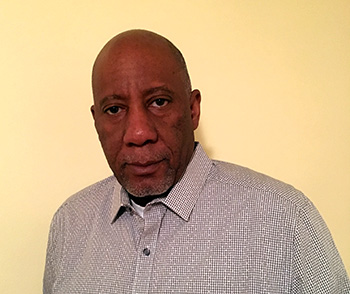Newsletter Edition: Spring 2021
Contributed by Gina Flores
A day in the life of Keith Rice’s career is never dull. The passion and pride he puts into his work as a historian/archivist at the Tom & Ethel Bradley Center in the University Library at CSUN deserves a radiant spotlight. From curating a museum exhibit to producing a documentary, Keith is making a positive impact in showcasing Black history, amplifying voices, and forging a visual pathway for social justice.
Get to know Keith, and the people and places that inspired him to pursue a career as a historian:
Tell us about your background.
I was born in Detroit, Michigan. I have always liked history, but not history classes. I enjoyed reading biographies during the cold winter months. I never considered becoming a historian because public school in the early 1970s did not teach Black history. I attended Oakland County Community College after high school but found it boring, so I joined the Air Force. My parents were part of the great migration from the South. My father was from Alabama and my mother from Georgia. My father, Arthur Rice Sr., had no more than a third-grade education and could only write his name. He attended an adult learning program when he retired from Chrysler Motor Company after thirty years. Although he was illiterate, he showed my siblings and I how to do all types of home and auto repairs, invest in the stock market, and to listen and learn from the people we came in contact with. My mother Ketrina Rice just turned 97 years old in December. She is from Sandersville, Georgia. It is also the birthplace of Berry Gordy, founder of Motown Records and Elijah Muhammad, the late leader of the Nation of Islam and spiritual leader of Malcolm X. She is the youngest and last surviving of 13 siblings and the only one to graduate from high school. Recently, I found out she attended Fort Valley State University, a historical Black college before moving to Detroit. At the time, Horace Mann Bond was the president of Fort Valley State and she told me about seeing his son, future civil rights leader, Julian Bond, as a toddler on campus.

What inspired you to become a historian/archivist?
Several things and people inspired me to become a historian/archivist. The first would be my father. I probably spent more time with him than my two brothers and sister. He would always tell me about people in our family in Alabama that he knew growing up. But he never really talked about what it was like growing up in the Jim Crow south during the 1920s and 30s. But we could tell by some of his statements that some of his encounters with white people were not pleasant. In addition to working at Chrysler, he used to collect and resale scrap metal. And we had to help. In spite of his experiences in the south he interacted with Italians, Polish, Jewish, and other ethnicities people all over Detroit.
Second, I had a career in the music business as a sound engineer just before turning my aspirations to history. For me, traveling around the world in the music business was the most important educational experience in my life. Between 2000 and 2008, I worked in thirty countries on three continents. Every opportunity I had I found myself taking in the local culture, trying to learn basic phrases of the languages, and visiting museums and historical sights. The more I learned about Europe, Africa, and Asia the more I realized how much I did not know about the Americas, and the United States in particular. In 2007, I took a one-day real estate seminar at Pierce College. Being in that classroom spoke to me. The space felt extremely comforting and welcoming.
Third, my cousin, Lynn was pushing me to go back to college because she had recently returned. She was relentless in telling me that she knew I would love it. Lynn graduated magna cum laude with an MBA. She knew me better than I knew myself at that point in my life and I followed her advice. I had attended West Los Angeles College in the 1980s, so I picked up where I left off. After I received my undergraduate degree in History at CSUN, I continued on to the graduate program. Every time I felt like giving up I would call her and rant and she would calm me down. I earned my graduate degree in May 2012. Lynn passed away the following March. She has joined the ancestors that we both called on to support us in our educational pursuits. Now I call on Lynn for support as I complete my dissertation in the History PhD program at Claremont Graduate University that I began in 2014.
What are some of your favorite projects, and which one are you most proud of?
Two of my favorite projects were exhibitions I co-curated at the Museum of Social Justice using materials owned or housed in the Bradley Center. One of the student volunteers at the Museum, Roberto Martinez, suggested that we do an exhibition about the Civil Rights Movement because his parents and their contemporaries knew very little about that part of American history. The African American Civil Rights Movement in L.A. exhibition opened in 2015. The exhibition was co-curated with student interns, volunteers, and members of the Museum’s board of directors.
In 1916, Katherine Higgins established the first Goodwill store in Southern California on the site of the Museum of Social Justice. The Bradley Center and the Museum of Social Justice were honored to be selected to curate an exhibition commemorating Goodwill’s first 100 years in Southern California. Goodwill: Its Founding and History in Southern California opened in 2016. My co-curator Lucy Hernandez and I worked closely with Goodwill and the board of the Museum to explore its founding through images, vintage clothing, and other three-dimensional materials located in the Museum’s and Goodwill’s archives. It was an amazing experience to recreate Goodwill’s history across such an expansive timeline.
Los Angeles: Displacement in Utopia is my proudest achievement yet. It is a mini-documentary that traces the history of racial restrictive housing covenants and its relationship to gentrification presently taking place in Southern California. My co-producers Dr. Karin Stanford and Pilar de Haro had never produced or directed a documentary prior to this undertaking. This turned out to be a massive undertaking to produce a 20-minute documentary. The outcome was well worth the blood, sweat, and tears we poured into this project. I would be remiss if I did not include my friend David Betances, who is an amazing director and editor, in my acknowledgements. He guided us throughout the project and when we became too frustrated to edit another frame of video, David took over editing duties and made the final product something we are all extremely proud of. The finished product could not have been achieved without David’s input and guidance.
Tell us about your engagement with CSUN students, and/or the local community in the pursuit of preserving and promoting Black history.
My engagement with students has always been a two-way street. I always look forward to hearing our interns, work study students, and student researchers say “I learned a lot about American history that I didn’t know before coming to the Bradley Center.” Those words always serve as a good reminder that we are doing the right things at the Bradley Center. But I always get just as much from the students as they get from me. I have great respect for their ideas and I rely on them expressing those ideas to keep what I do at the Bradley Center relevant. I like to look at it as an exchange of information between myself and the students.
When working with the African American community, being an African American historian is not enough. My word to community members is everything. Just doing this work on behalf of a university carries very little weight because the relationship between Black folks and many institutions in this country has not always been positive. Black history has been overlooked, revised, stolen, and even erased. Positive relationships with several underserved communities were established before I began my service in the Bradley Center and it is so important that it continues. For me, it is a humbling experience to be entrusted with preserving and promoting the history of the underserved communities in Los Angeles and beyond.
One of our latest projects came about quite unexpectedly and involved activities that lay outside the norm for traditional archival work. Documenting the protests against the killings of Black people at the hands of law enforcement last year was an extremely powerful and rewarding experience. The community was so appreciative that CSUN was documenting their fight for justice against an unjust culture of law enforcement in this country. It was such a humbling experience to have so many young people say “thank you for doing this.” It is an experience I will never forget because of their passion, conviction, and desire to bring about a stop to this country’s ongoing racial injustices (see 2020 BLM Protests in LA).
All of my projects have been collaborative. I feel that in order for me to provide the best experience to the audience, I have to work collaboratively with colleagues, students, and the community. Working with CSUN students and the local community benefits all parties.
What’s next?
In addition to our photographic preservation and digitization projects, we are making several oral history interviews with members of the Black Power Movement available for dissemination. In the last five years, Dr. Karin Stanford and I have conducted interviews with members of the local (but nationally influential) Black Power Movement. As with many movements, the history is often told by non-participants. Our goal with these interviews is to let students, scholars, and members of the public see and hear the actual people behind the movement share its history. We have been awarded one of the CSUN Diversity and Equity grants to prepare these primary source videos available for dissemination.
Check out Keith's Videos: CSUN Bradley Center Archivist Sherwin Keith Rice on the Beat on 1, Spectrum News, January 31, 2019:
Civil Rights Historian Says Protests Are a 'Symbol of Black Power'
